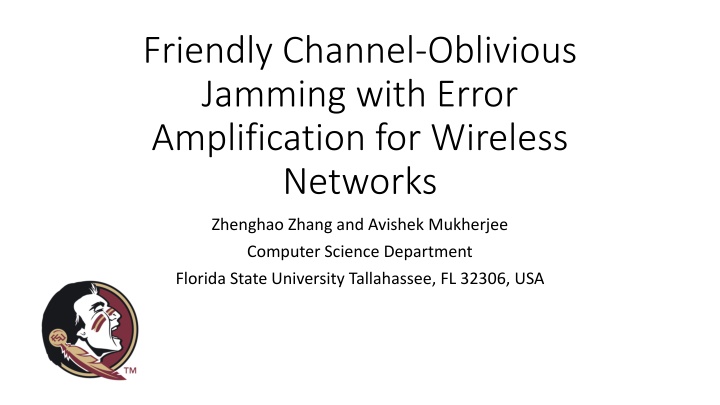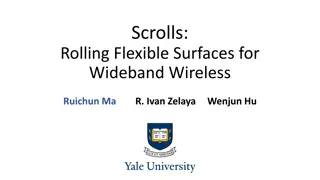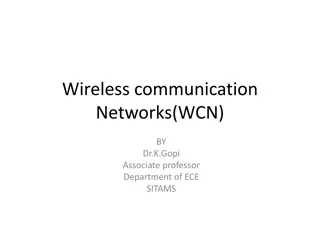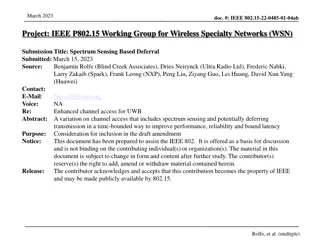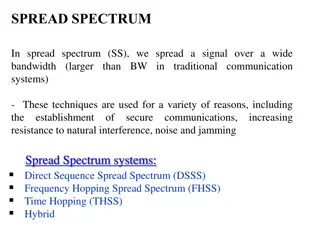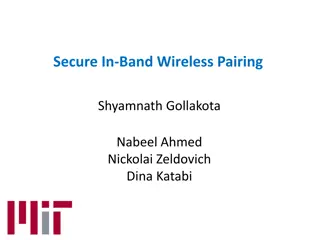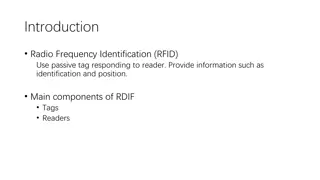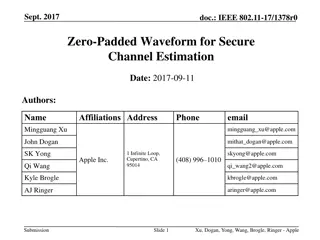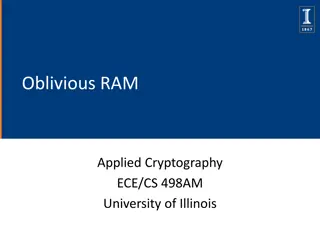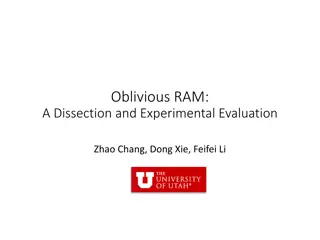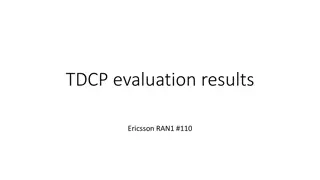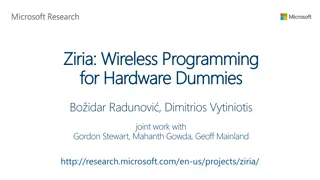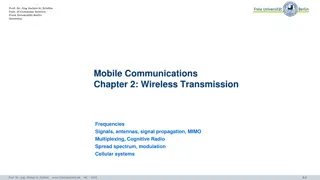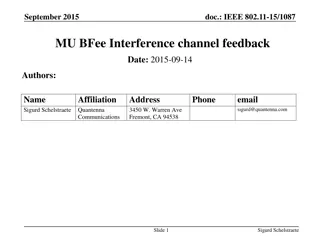Secure Wireless Communication with Channel-Oblivious Jamming
Wi-Fi usage in various settings poses security risks due to the open transmission of signals. This study explores a method using jamming signals to prevent eavesdroppers from decoding packets without password protection, while allowing legitimate users to receive the data correctly. By introducing a jammer with multiple antennas that strategically cancels out interference at the legitimate user's location, the system aims to enhance data security in wireless networks.
Download Presentation

Please find below an Image/Link to download the presentation.
The content on the website is provided AS IS for your information and personal use only. It may not be sold, licensed, or shared on other websites without obtaining consent from the author.If you encounter any issues during the download, it is possible that the publisher has removed the file from their server.
You are allowed to download the files provided on this website for personal or commercial use, subject to the condition that they are used lawfully. All files are the property of their respective owners.
The content on the website is provided AS IS for your information and personal use only. It may not be sold, licensed, or shared on other websites without obtaining consent from the author.
E N D
Presentation Transcript
Friendly Channel-Oblivious Jamming with Error Amplification for Wireless Networks Zhenghao Zhang and Avishek Mukherjee Computer Science Department Florida State University Tallahassee, FL 32306, USA
Wi-Fi is widely used homes offices public hot spots, e.g., coffee shops, air ports, college campus
Security of Wi-Fi Signal is sent in the open air, everyone nearby can overhear Password can solve the problem, however not in open networks The problem we are interested in: how to prevent an eavesdropper from being able to decode the packet without password protection, while ensuring the legitimate user can get the packet correctly
General Approach Legitimate user Eavesdropper Introducing a jammer with multiple antennas When the sender transmits a packet, the jammer transmits jamming signal simultaneously, but the jamming signal is generated such that it is 0 at the legitimate user but most likely non-zero elsewhere Sender Jammer
General Approach Same Legitimate user Opposite Eavesdropper phase, add up How this is achieved, roughly speaking: The jamming signal is a sine wave One sine wave on each antenna The jammer supposedly know the phase lag to the legitimate user, and adjusts the phases of sine waves such that it cancels at the legitimate user, but most likely not at other locations [STROBE, Infocom 2012] phase, cancel Sender Jammer
Challenges (1) Legitimate user Eavesdropper The jamming signal power at any time is not going to cover the entire area, just leaving a hole near the legitimate user It may happen that the sine waves also have opposite phases at a different eavesdropper Cannot control really because the eavesdropper may be at any location with any phase lag Not jammed Jammer
Challenges (2) Even when jammed, if the data packet is modulated at a low data rate, with strong error correction code, not going to have a lot of errors! Results collected with Microsoft Sora when the jamming signal is generated according to STROBE The eavesdropper still can get MOST bits right!
Our Contribution (1) AAAAAAAA AAAAAAAA Data Data Proposes to employ an error amplifier that can turn just a few errors into many errors Before sending the data, map it to another string according to a random permutation After receiving, map the received string according to the reverse of the random permutation Mapped Mapped BBBBBBBB BBBBBBBB Received Received BBBBBBBB BBBB3BBB Reverse Map Reverse Map AAAAAAAA 89EF2DF1
Error Amplifier Can use AES to implement the error amplifier
Error Amplifier The argument is that will have to do this anyway because jamming only cannot turn enough data bits into errors The catch is that both sender and the legitimate user would have to install the error amplifier
Our Contribution (2) jMax: a jamming strategy that exploits the error amplifier to more effectively protect user privacy by maximizing the maximum jamming power to any eavesdropper, without knowing the phase lags (CSI, to be exact) of any eavesdropper
jMax The error amplifier is going to just need a few error bits, so the jamming power to any potential eavesdropper need not be constant high power, which is hard to achieve, instead can be just a spike
jMax Legitimate user Eavesdropper Not knowing the phase lags (CSI) to the eavesdroppers, will just try multiple sets of phase adjustments (jamming vector), each time will cover some areas and leave some holes, but any eavesdropper will unlikely to be in the holes every time Jammer
jMax Current design uses 10 jamming vectors, where 1 and 2 are the orthogonal base of the space orthogonal to the legitimate user s CSI Theorem: The maximum jamming power jMax introduces to any eavesdropper at least of the optimal jamming power.
jMax Intuition: Any valid jamming vector (the vector to determine the phase and amplitude of the sine waves from each antenna) has to be a linear combination of 1 and 2 The selected jamming vectors are in some sense evenly distributed in the linear space spanned by 1 and 2 and therefore not too far from any vector in this space
jMax Practical Considerations For OFDM systems, basically use the same procedure for each subcarrier One concern is that as different subcarriers have different CSI, their peak power may not be arrived at the same time
jMax Practical Considerations Fortunately, the CSIs of different subcarriers show a lot of correlation The right is two typical cases of received jamming powers at different subcarriers for the 10 jamming vectors CSI collected with the Intel 5300 wireless card
Evaluations Used the Intel 5300 wireless card with 3 tx and rx antennas to collect the CSI as the CSI a jammer to the user and multiple eavesdroppers
Evaluations Used Microsoft Sora to transmit packets at all 802.11a data rates (6,9,12,18,24,36,48,54 Mbps) at 3 packet sizes (80, 320, 960 bytes), and recorded the waveform in the air Our Sora machine has only one antenna, so we assume the sender, user, eavesdroppers all have one antenna
Evaluation We assume the jammer has 3 antennas, and generate the jamming signal according to jMax jamming vectors, then add the jamming signal to the packet waveform in software, then run the Sora offline decoder
Compared Method 2-ANT: uses only two antennas, cannot change jamming vectors STROBE: uses all antennas, multiplies either 1 or -1 randomly with 1 and 2 uses the sum Optimal: uses all antennas, knows the CSI to the eavesdropper
Performance JSR: tx power of jammer to the tx power of the sender ratio 8 bit errors means a successful jam Solid gains over STROBE and 2-ANT JSR needs to be quite large for low data rates and lower for higher data rates The curve has a large transition range, meaning that some are easy to jam and others more difficult
Jamming Failure Ratios A jamming method may fail to jam certain client and eavesdropper pairs even when the jamming power the largest value we take in the evaluation jMax is much lower than Strobe and 2-Ant The gain of 3-antenna methods over 2-Ant suggests that more antennas will further reduce the failure ratio
Jam Power Ratio Find the maximum power ratio of various methods over Optimal The ratio of jMax roughly matches the theoretical bound
Thank you! Thank you!
